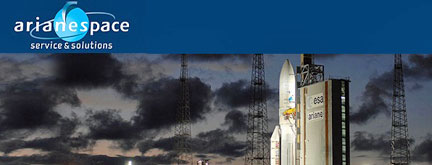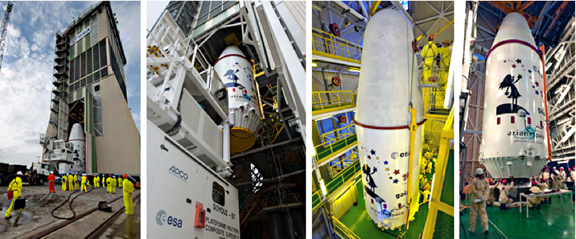
[SatNews] The Gaia billion-star mapper is one major step closer to its unprecedented exploration mission, as the European-built spacecraft has now been positioned atop Arianespace’s Soyuz launcher in French Guiana.
This integration occurred during a busy weekend of activity at the Spaceport, in which the basic three-stage Russian-built Soyuz vehicle rolled out from its MIK integration building and was erected on the launch pad. It was followed by transfer of the mission’s payload “stack”—consisting of Gaia, the Fregat upper stage, and their protective fairing—for integration atop Soyuz, which is inside a mobile gantry.

Gaia’s integration is shown in these photos on the launch pad at French Guiana, beginning with the spacecraft’s delivery by a special vehicle to the mobile gantry that protects Arianespace’s Soyuz launcher (at left). The payload “stack” is then raised to the gantry’s upper levels (center images) and integrated on the Russian-built workhorse vehicle (at right).
Photos are courtesy of Arianespace.
The mission’s star-mapping theme is evident with its logo affixed on the payload fairing, which portrays Gaia (the Greek mythological Mother Goddess) looking at the Milky Way and a representation of the Gaia spacecraft.
Appropriately, another field of stars is located on the transporter/erector used for the Soyuz’ horizontal rollout and its raising to vertical position on the launch pad. Following a Russian tradition, the transporter/erector’s strongback has an array of five stars – representing the number of missions performed to date with the medium-lift workhorse from this launch site.
Gaia will be lofted by Arianespace during an early morning French Guiana liftoff on December 19, placing this spacecraft on a trajectory to an orbital position at the L2 Lagrangian point some 1.5 million kilometers beyond Earth’s orbit. Capable of detecting celestial objects that are a million-times fainter than the unaided human eye can see, Gaia is equipped with two optical telescopes to determine star locations and velocities, along with three science instruments and one of the largest digital cameras ever to be placed in space.
The spacecraft has an estimated liftoff mass of 2,034 kg. and was produced by Astrium for a mission developed and operated by the European Space Agency. Gaia will monitor each of its one billion target stars approximately 70 times during a five-year period, precisely charting their positions, distances, movements and changes in brightness. The mission is expected to discover hundreds of thousands of new celestial objects – including asteroids, comets, extra-solar planets, brown dwarf “failed stars,” supernovae and quasars. This week’s flight with Gaia will mark the 25th scientific satellite launched by Arianespace.
Arianespace' infosite for further information: http://www.arianespace.com/

